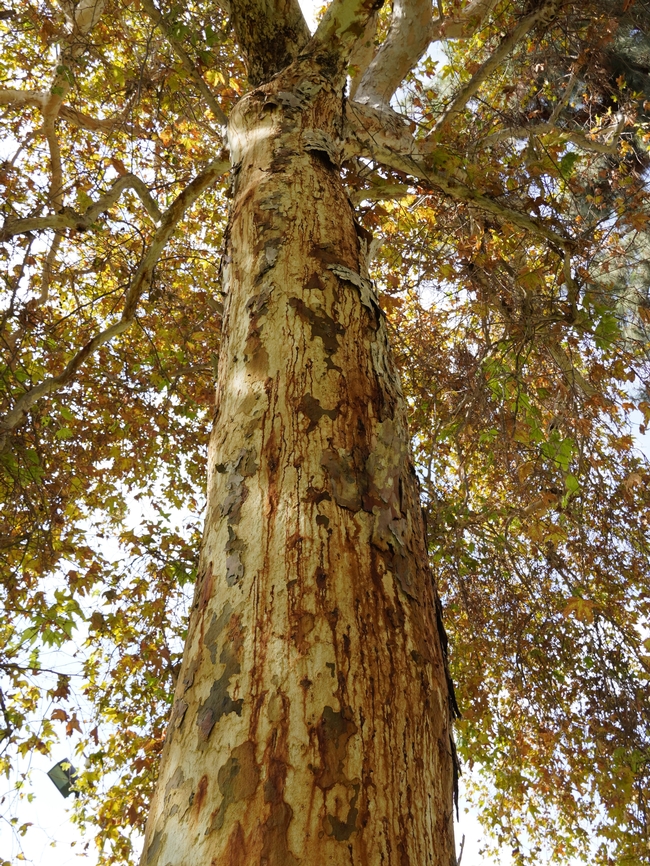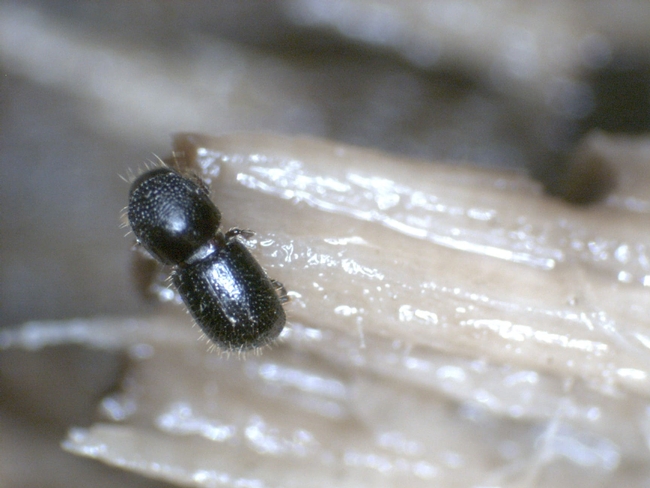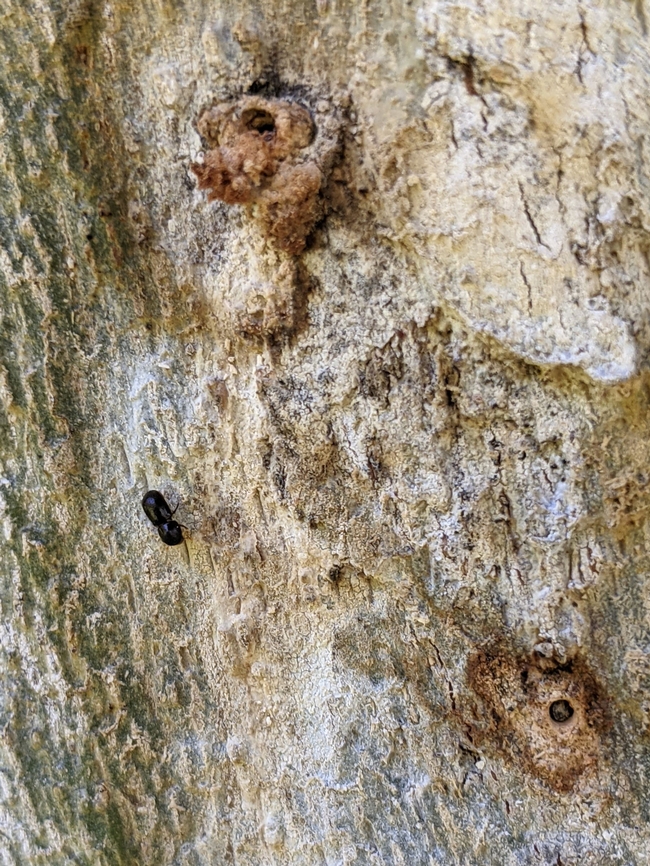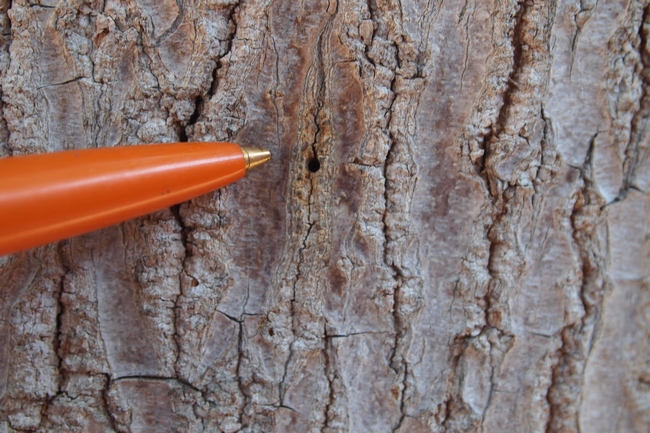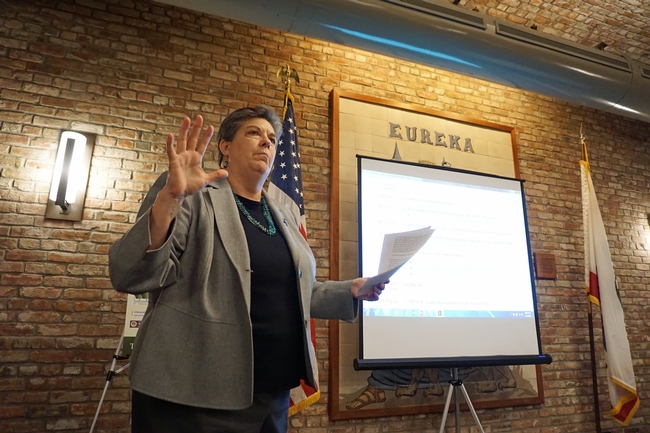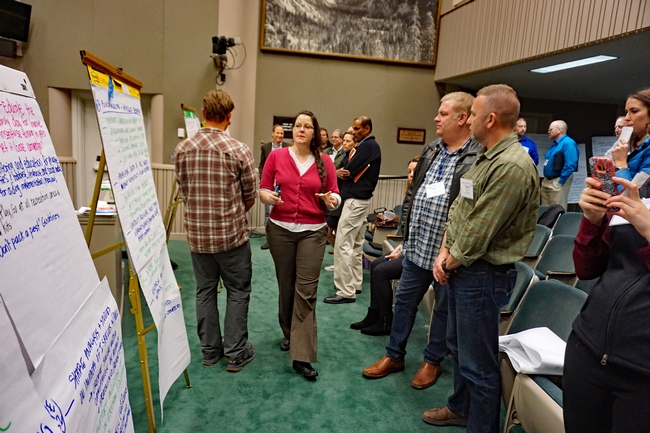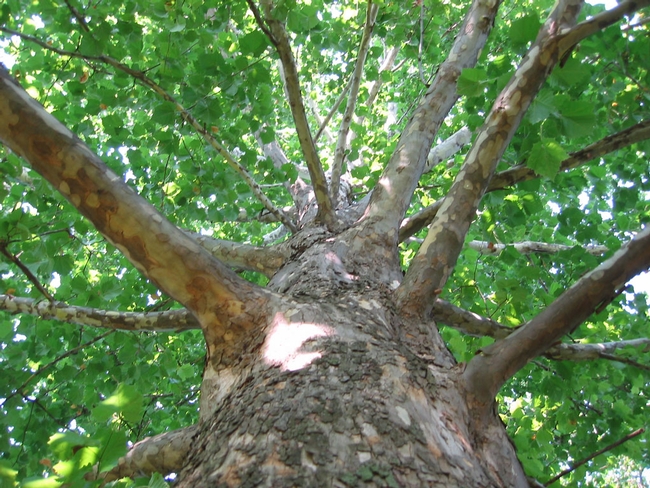Posts Tagged: Kabashima
After shothole borer invasion, UC Irvine becomes ‘perfect testing ground’
Results help inform best practices for managing the disease-causing beetle
The University of California, Irvine campus is home to a vast urban forest consisting of approximately 30,000 trees located in a mix of landscape, riparian and open space settings. In the mid-2010s, that forest came under threat from an invasive species of beetle that arborists and pest researchers were just learning about – the polyphagous shothole borer.
The tiny beetles, which may have arrived in California from their native Southeast Asia via infested shipping materials, tunnel into trees and introduce a fungus that serves as food for adult beetles and their larva.
As the fungus grows, it colonizes the tree's vascular system, blocking transport of water and nutrients. This causes a disease called Fusarium dieback that can kill branches or entire trees.
Shothole borers attack more than 100 species of trees and can live and reproduce in more than 65 tree species found in California. However, they seem to prefer box elders, sycamores and willows.
One reason the beetles were such a threat at UCI was the high number of sycamores on campus, especially in Aldrich Park at the campus center. Hundreds of cottonwoods, native willows, golden rain and coral trees also were affected. In total, the beetles attacked more than 2,000 trees, including 75 different tree species.
A variety of approaches to controlling beetle
To better understand and tackle this problem, UCI's Facilities Management department and Office of Environmental Planning and Sustainability collaborated with researchers affiliated with UC Agriculture and Natural Resources and UC Cooperative Extension. In addition, pesticide-manufacturing companies, pest control advisers and arborists provided materials and labor to help offset the cost of research.
“UCI was the perfect testing ground to determine integrated pest management strategies for this beetle/disease complex,” said John Kabashima, UCCE environmental horticulture advisor emeritus. “Our research was multifaceted, delving into early detection, monitoring and sampling, and cultural and chemical management.”
Kabashima said UCI provided the researchers with “a lot of freedom” to try a variety of approaches and study the results over time.
“We could cut down and sample trees or leave selected infested trees alone; we explored a variety of pesticide/fungicide combinations and application techniques,” he said. “That freedom resulted in many of the management solutions that are used today to effectively control this pest.”
UCI and the researchers also established a full inventory of affected trees on campus, evaluating severity of infestation by the number of entry/exit holes and signs of dieback. One important key to management is getting rid of “amplifiers” – heavily infested trees that are both hazardous and a source of beetles to spread to other trees.
“Typically, shothole borer infestations begin with just a few trees that for some reason are highly attractive to the beetles – perhaps based on tree species, tree spacing, irrigation conditions or other factors,” Kabashima said. “Over time, the beetles and fungus multiply largely undetected in those few trees. When the beetle population reaches a critical point and the trees begin to die, the female beetles fly to adjacent trees in a secondary invasion, eventually infesting many trees over a large area.”
An opportunity to diversify UCI's urban forest
At UCI, that initial invasion took place in landscaped areas containing many large, majestic sycamores that were planted when the campus began operations in the mid-1960s.
Over several years, UCI removed 700 heavily infested trees, including many of those historic sycamores, and replaced them with other tree species.
“We tip-toed into tree diversity, looking for other tree species that might be less susceptible to attack; we looked at 300 tree species that could be suitable for creating a more diverse tree forest as opposed to a street tree approach.” said Matthew Deines, senior planner with UCI Campus Physical & Environmental Planning. “We also planned for some redundancy in how we planted: If we had space, we would plant two trees of a single species and then plant backups with other species – what we did not want was a monoculture.”
Today, the forest at UCI is very different than it was in 2015. While shothole borers have not been eliminated completely, their presence is reduced significantly, and UCI now has the tools to manage them effectively. Reforestation efforts resulted in a diverse treescape that is not only more sustainable but also beautiful.
“Managing a 1,500-acre campus with 30,000 trees is a never-ending process,” said Richard Demerjian, UCI's assistant vice chancellor, Campus Physical & Environmental Planning. “Our forest continues to evolve, with an ongoing focus on increasing diversity and plant health.”
Demerjian also noted that UCI is now starting to consider planting new sycamore trees on a limited basis.
A primer on effective shothole borer management
Whether managing a forest of thousands of trees or just a few trees, landscape managers and residents can apply many of the lessons learned at UCI to control invasive shothole borers and other tree pests.
- Avoid monocultures. Tree diversity provides beauty and resiliency.
- Keep trees healthy. Proper irrigation and maintenance will keep trees strong and help protect them from shothole borers and other pests.
- Check trees. Look for the common signs and symptoms of infestation such as beetle entry/exit holes. Regular monitoring ensures that infestations are managed early, before they cause dieback or tree death.
- Confirm suspected infestations. Use the detection tool at www.ishb.org.
- Review management options. For trees with low infestation, prune the infested branches and monitor the tree's health over time. In non-riparian, urban settings, consider treating low and moderately infested trees with pesticides/fungicides demonstrated to be effective against the pest-disease complex (A licensed professional will be needed to apply the treatments). Severely infested trees may require removal.
- Call in a professional. A certified arborist or pest control professional would be able to provide recommendations based on the tree's condition. The local county Agricultural Commissioner's Office and UC Cooperative Extension office may have additional knowledge about current shothole borer monitoring and management programs in your area.
- Take care of green waste. The beetles can survive in cut wood for weeks or even months. Proper disposal of green waste includes chipping infested wood, followed by solarizing or composting the chips.
- Replant wisely. Begin planting new trees only after removing all amplifiers and establishing an ongoing monitoring program. Consider the current concentration of tree species when deciding what type of trees to plant.
Ag leaders, scientists set priorities to prevent invasive pest threats to the environment and economy
The gypsy moth, an interloper from Europe and Asia, is threatening California's majestic oaks in Ventura County.
Invasive desert knapweed, which comes from Africa, has made its first North American appearance in in California's Anza-Borrego Desert, where it has started to crowd out native plants.
Asian citrus psyllids are slowly spreading the devastating huanglongbing disease in Southern California citrus.
River rats from South America, called nutrias, are munching voraciously on wetland plants in some areas of Stanislaus, Merced and Fresno counties.
These are just a few of the insects, weeds, animals and diseases that have entered the state of California from elsewhere on the globe, causing tremendous ecological damage and huge economic losses to agricultural crops, which ultimately affect every resident of California.
Based on historical data, a new invertebrate species establishes itself in California about every six weeks, on average. They don't all become serious pest problems, but many evade eradication efforts, disrupt carefully balanced integrated pest management programs, hijack sensitive ecosystems, and spoil valued recreational resources and urban landscapes.
A diverse group of university scientists, federal and state government representatives, county agricultural commissioners and non-profit organization leaders who are battling these pests converged at a summit in the state capitol Jan. 11 and 12 to coordinate their efforts, pool intellectual resources, and plot a strategy for protecting agricultural crops, natural resources, unique ecological communities, cityscapes and residential neighborhoods.
“We are a big, beautiful, special place, blessed with great weather and diverse geography,” said California Department of Food and Agriculture Secretary Karen Ross at the summit. “That means a lot to our many visitors – including pests.”
Glenda Humiston, vice president of UC Agriculture and Natural Resources, which co-sponsored the summit, outlined the goals.
“We know that collectively, we have the tools and expertise to prevent invasive species from entering California, spreading and becoming established,” Humiston said. “I am so pleased with the numbers of people here today, and the expertise that you bring.”
A fundamental component of the fight against damaging invasive species is research, Humiston said, adding that the European grapevine moth in an apt example. The pest was detected in California's wine country in 2009, and later found as far south as Fresno County. A multi-agency collaboration responded quickly.
UC ANR academics studied the moth's biology, life cycle, host range and proven management practices. They developed a pest management program that relied on mating disruption with pheromones and application of carefully timed insecticides. In short order, the moth population plummeted, and the state was declared free of European grapevine moth, lifting a quarantine, enhancing farmers' ability to export its product, and preserving the communities' economic wellbeing.
“This multi-agency collaboration contributed to a successful, science-based response plan to a serious pest threat,” Humiston said.
She noted, however, that prevention is the best option.
“This is critical,” Humiston said. “Once the pests are here, they cost us millions upon millions of dollars to manage, not to mention the devastation and destruction inflicted on our crops, natural resources and the damage to local economies.”
In 2010, CDFA created a strategic framework for addressing California's ongoing invasive pest problems and potential future introductions. Successful implementation of the framework requires partnerships involving government from the state to local levels, the agriculture industry and commodity groups, non-governmental organizations committed to the environment, and researchers at UC and other universities.
UC Cooperative Extension advisor emeritus John Kabashima was instrumental in bringing the summit to fruition. Kabashima, who retired in 2015, continues to lead a battle against invasive shot hole borer pests in Southern California. The insects, originally from Asia, are killing thousands of Southern California trees, and have the potential to kill millions of trees in urban areas, natural areas and even on farms in parts of the state as far north as Sacramento.
“We convened this meeting to bring together experts in the field and people who are feeling the impacts,” Kabashima said. “We're trying to start a 21st century invasive pest program that would then be implemented and funded to address the urgent issues before they cause any more devastation.”
At the end of the two-day summit, the participants voted to decide the most pressing issues and best strategies to take forward to their agencies, coalitions, research groups, legislators and constituents. Key strategies that emerged were:
- Analyze the economic impacts of invasive species management and the cost of “doing nothing.”
- Develop and maintain statewide surveys and map high-risk surveys.
- Increase funding to study invasive species' biology.
- Create a standing rapid response workgroup to guide response to new invasive species. Fund a rapid response emergency fund.
- Enact regulations to control high-risk vectors, such as soil, green waste, gravel, forage, straw and firewood.
- Formalize the Invasive Species Council of California (ISCC) and the California Invasive Species Advisory Committee (CISAC).
Mark Hoddle, UC Cooperative Extension biological control specialist and director of the Center for Invasive Species Research at UC Riverside, said the summit was a valuable part of the ongoing battle against invasive pests.
“It's good to see the number of agencies and organizations involved with invasive species issues,” Hoddle said. “I'm impressed with the energy in coming up with these priority lists.”
Summit outcomes will include sending recommended action items to the Legislature for funding consideration.
“Without financial support, many of the management tools that prevent unwanted incursions, find and monitor incipient pest populations, and develop sustainable, cost-effective management programs won't be possible,” Hoddle said.
View Glenda Humiston's opening remarks here:
Loss of trees could portend loss of human life
An invasive pest from Asia is killing thousands of trees in Southern California, which may lead to the death of thousands of humans, reported Adam Rogers on Wired.com.
Polyphagous shot hole borer females drill holes inside trees to lay their eggs. In the process, they deposit a fungus that grows and provides food for larvae. The fungus gums up the trees' channels for water and nutrient transport, eventually killing it. Called Fusarium dieback, the condition is on track to kill 26.8 million trees across Southern California in the next few years.
With data from a U.S. Forest Services study, which found that fewer trees is related to respiratory and cardiovascular disease deaths in people, the reporter underscored the dire human-health implications of polyphagous shot hole borer.
Trees also provide valuable "ecosystem services," such as reducing light and heat intensity, protecting water, cleaning the air of pollutants, providing wildlife habitat and storing carbon. The forest service combined satellite data and field plot data to calculate the costs and benefits of trees. The potential loss of ecosystem services because of polyphagous shot hole borer is $1.4 billion, not including the public health cost.
“A normal response to an invasive pest means millions of dollars would be thrown at it,” said John Kabashima, UC Cooperative Extension advisor emeritus who is working on staving off a catastrophe. “This one has received hundreds of thousands.”
Kabashima and other scientists are identifying infected trees to cut them down and chip the wood to prevent further spread. The tell-tale signs are little holes and sugar volcanoes that tend to show up first on the north side of the trunk or limb.
"You have to get out and walk around each tree, which we're doing in Orange County parks," Kabashima said. "We go out on off-road Segways. We can cover square miles in a day."
UC Cooperative Extension uses UC Irvine campus as a living lab
"The beauty of UCI is that it's a university, and they're used to researchers," said John Kabashima, an environmental horticulture advisor and entomologist with the UC Cooperative Extension in Orange County.
Another scientist on the project is Akif Eskalen, UC Cooperative Extension plant pathology specialist based at UC Riverside. Eskalen first identified the sesame seed-sized beetle in a South Gate avocado tree in 2012.
Eskalen selected 130 sycamores at UCI for his experiment and divided them into 13 groups of 10. Four of the groups were treated with different insecticides; three were treated with different fungicides; and four others got one of each. Another group was given a beneficial bacteria found in some California trees that's thought to kill the fungus. A final group is serving as a control and received no treatment at all.
The scientists are allowed to cut down and section the trees, sample them, and even leave some infested trees alone. Having this flexibility is essential to understanding the success — or failure — of a given pesticide, Kabashima said: "That's why we're learning so much here at UCI."
Team of scientists tackle shot hole borer at UC Irvine
When trees at UC Irvine became infested with polyphagous shot hole borer, the university assembled a team of scientists to use the campus as a living laboratory to study ways to protect trees from the pest, reported Sanden Totten on KPCC, the public radio station in Southern California.
Two members of the team are UC Agriculture and Natural Resources experts: Akif Eskalen, UC ANR Cooperative Extension specialist in the Department of Plant Pathology at UC Riverside, and John Kabashima, UC ANR farm advisor emeritus.
PSHB, a native of Asia, is killing hundreds of trees at UCI and thousands of trees in Orange, Los Angeles, and San Diego counties, including ornamental trees in urban landscapes, avocado and other farm trees in agricultural areas, and native tree species on wildland.
"The value of trees killed by PSHB will be in the millions of dollars," Kabashima said.
The pest damages trees by boring into the bark and carrying a fungus inside.
"They actually farm that fungus as a food source," Eskalen said.
The fungus clogs the water-conducting tissue inside the tree, leading to the tree's death.
The scientists are battling the pest on many fronts, injecting various insecticide and fungicide combinations to kill the pest and fungus, and even limiting water to some trees to see if dry conditions will have an impact on the pest and fungus. However, the scientists acknowledge the complexity of the problem.
"When we do a test on sycamores that does not necessarily translate to what's going to happen when we treat an oak," Kabashima said.
For that reason, Eskalen says it's unlikely researchers will be able to eradicate the pest.
"At the end, we're going to have to learn to live with it," he said.


